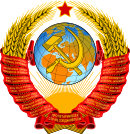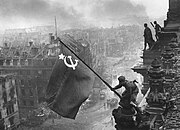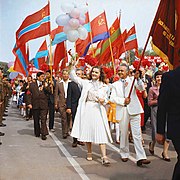Flag of the Soviet Union
| Proportion | 1:2 |
|---|---|
| Adopted | December 1922 (original) 19 August 1955 (last version) |
| Relinquished | 26 December 1991 |
| Design | Plain red banner, with the canton consisting of a gold hammer and sickle topped off by a red five-point star bordered in gold |
| Part of a series on the |
| Culture of the Soviet Union |
|---|
 |
| People |
| Languages |
| Traditions |
| Cuisine |
| Festivals |
| Literature |
| Music |
|
Sport |
The State Flag of the Union of Soviet Socialist Republics (Russian: Госуда́рственный флаг Сою́за Сове́тских Социалисти́ческих Респу́блик Gosudárstvenny flag Soyúza Sovétskikh Sotsialistícheskikh Respúblik), or simply the Soviet flag (Russian: Сове́тский флаг Sovétsky flag), was a red banner with two communist symbols displayed in the canton: a gold hammer and sickle topped off by a red five-point star bordered in gold. The flag's design and symbolism are derived from several sources, but emerged during the Russian Revolution. It has also come to serve as the standard symbol representing communism as a whole, recognized as such in international circles, even after the dissolution of the Soviet Union in 1991.
The plain red flag, which was a traditional revolutionary symbol long before 1917, was incorporated into the Soviet flag to pay tribute to the international aspect of the workers' revolution. On the other hand, the unique hammer-and-sickle design was a modern industrial touch adopted from the Russian Revolution; it represented the "victorious and enduring revolutionary alliance" by unifying the hammer (i.e., workers) and the sickle (i.e., peasants). The gold-bordered five-point star situated above the hammer and sickle was a representation of the Communist Party of the Soviet Union.
The first flag was adopted in December 1922. In 1923, 1924, 1936 and 1955, statutes were adopted that resulted in adjustments to the hammer's handle length and the sickle's shape. In 1980, an amendment was made to the 1955 decree that removed the hammer and sickle displayed on the
Symbolism and design
The flag of the Soviet Union consisted of a plain
The colour
The hammer symbolises urban
The flag's design was legislated in 1955, which gave a clear way to define and create the flag. This resulted in a change of the hammer's handle length and the shape of the sickle. The adopted statute stated that:[4]
- The ratio of width to length of the flag is 1:2.
- The hammer and sickle are in a square with sides equal to 1⁄4 of the flag's height. The sharp tip of the sickle lies in the center of the upper side of the square, and the handles of the hammer and sickle rest in the bottom corners of the square. The length of the hammer and its handle is 3⁄4 of the square diagonal.
- The five-pointed star is inscribed into a circle with a diameter of 1⁄8 of the flag's height, the circle being tangent to the upper side of the square.
- The distance of the vertical axis of the star, hammer and sickle from the hoist is 1⁄3 of the flag's height. The distance from the upper side of the flag to the center of the star is 1⁄8 of the flag's height.
Officially since 1980, the reverse side of the flag was a plain red field without the hammer and sickle. In practice, however, this was very commonly disregarded by flag makers as it was far easier and less costly to simply print the flag
For vertical display, the flag was made with the distinct difference of having the hammer and sickle rotated 90 degrees in order to compensate for the change in dimensions. Although common in official practice, a typical flag owner would simply turn a standard design flag 90 degrees to the right and hang it by the
History
During the establishment of the
The first official flag was adopted in December 1922 at the First Congress of Soviets of the USSR. It was agreed that the red banner "was transformed from the symbol of the Party to the symbol of a state, and around that flag gathered the peoples of the soviet republics to unite into one state — the Union of Soviet Socialist Republics". On 30 December 1922, the Congress adopted a Declaration and Agreement on the establishment of the USSR. Article 22 of the Agreement states: "The USSR has a flag, coat of arms and a state seal." The description of the first flag was given in the
In the third session of the CIK of the USSR, the description of Soviet flag in the Constitution was changed, and article 71 was edited to read: "The state flag of the Union of Soviet Socialist Republics consists of a red or scarlet field, and in the canton a golden sickle and hammer, and a red five-pointed star bordered in gold above them. The ratio of width to length is 1:2." On 19 August 1955, the Statute on the State Flag of the Union of Soviet Socialist Republics was adopted by a decision of the
On 15 April 1996
Contemporary usage
In current times, the Soviet national flag (and similar flags) are widely used by those on the political far left, most often by those who support Marxism–Leninism, although the earlier (pre-Stalinist) flags are occasionally used by Trotskyists and those on the modern communist left.
The Soviet flag is also actively promoted in Russia as a symbol of nostalgia for the Soviet Union. Various politicians frequently utilize it as a symbol of the superpower status Russia lost in 1991.[10]
Amidst the backdrop of the
On June 17, 2023, during the celebration for the 300th anniversary of Saint Petersburg, the flags of the Russian Empire (Black-yellow-white flag), Soviet Union and Russian Federation raised simultaneously at the Gulf of Finland.[13][14][15][16]
- Historical evolution of the flag of the Soviet Union
-
(30 December 1922 – 12 November 1923)
-
(12 November 1923 – 18 April 1924)
-
(18 April 1924 – 5 December 1936)
-
(5 December 1936 – 19 August 1955)
-
(19 August 1955 – 26 December 1991)
Derived flags
The
or modified versions of the Soviet flag.-
Russian Soviet Federative Socialist Republic(1954–91)
-
Ukrainian Soviet Socialist Republic(1937–50)
-
Ukrainian SSR
(1950–91) -
Byelorussian Soviet Socialist Republic(1937–51)
-
Byelorussian SSR (1951–91) (served as an inspiration for the flag of Belarus since 1995)
-
Uzbek Soviet Socialist Republic(1952–91)
-
Kazakh Soviet Socialist Republic(1937–40)
-
Kazakh SSR (1940–53)
-
Kazakh SSR and Kazakhstan (1953–92)
-
Georgian Soviet Socialist Republic(1951–90)
-
Azerbaijan Soviet Socialist Republic(1924–27)
-
Azerbaijan SSR
(1927–31) -
Azerbaijan SSR
(1931–37) -
Azerbaijan SSR
(1937–40) -
Azerbaijan SSR
(1940–52) -
Azerbaijan SSR
(1952–56) -
Azerbaijan SSR
(1956–91) -
Lithuanian Soviet Socialist Republic(1940–53)
-
Lithuanian SSR
(1953–88) -
Moldavian ASSR
(1937–38) -
Moldavian ASSR
(1938–40) -
Moldavian Soviet Socialist Republic
(1940–52) -
Moldavian SSR (1952–1990)
-
Pridnestrovian Moldavian Republic[note 2] (1991–present)
-
Latvian Soviet Socialist Republic(1940–53)
-
Latvian SSR (1953–67)
-
Latvian SSR (1967–90)
-
Kirghiz Soviet Socialist Republic and Kyrgyzstan (1952–92)
-
Tajik Soviet Socialist Republic(1936–38)
-
Tajik SSR (1938–40)
-
Tajik SSR (1940–53)
-
Tajik SSR (1953–91)
-
Armenian Soviet Socialist Republic(1936–40)
-
Armenian SSR
(1940–52) -
Armenian SSR
(1952–90) -
Turkmen Soviet Socialist Republic(1926–37)
-
Turkmen SSR (1953–73)
-
Turkmen SSR and Turkmenistan (1973–92)
-
Estonian Soviet Socialist Republic(1940–53)
-
Estonian SSR (1953–90)
-
Karelo-Finnish SSR (1953–56)
-
Victory Banner of the Great Patriotic War (1945)
-
Flag of Vladimir Oblast (1999–2017)
-
Flag of Vladimir Oblast (2017–present)
Gallery
-
The Soviet flag along with an assortment of Russian and Soviet military flags
-
Flags of the Soviet Republics flown during a parade inMoldavian SSR
-
One of the last Soviet flags flown on the Kremlin, displayed at the Checkpoint Charlie Museum in Berlin
-
Member of the Armed Forces of Belarus pays tribute to the Victory Day in 2014, in front of a Soviet flag
See also
- Communist symbolism
- Flag of Russia
- Flags of the Soviet Republics
- Flags whose reverse differs from the obverse
- Hammer and sickle
- Red flag
- Red star
- State Emblem of the Soviet Union
Notes
- ^ In vexillology, defacement is the addition of a symbol or charge to a flag.
- Pridnestrovian Moldavian Republic or Transnistria, is an unrecognized breakaway republic formed in 1991 after the breakup of the Soviet Union from territory internationally recognized as part of Moldova after the Transnistria War.
- ^ The Karelo-Finnish SSR was a short-lived Union Republic formed in 1940 from the Karelian ASSR with territory ceded from Finland in the Winter War. In 1956, it was demoted back to an ASSR within the RSFSR.
References
- ^ Whitney Smith (2008). "Flag of Flag of Union of Soviet Socialist Republics". Encyclopædia Britannica. Retrieved 2008-11-05.
- OCLC 4957064.
- ^ "Положение о Государственном флаге Союза Советских Социалистических Республик | Геральдика.ру". geraldika.ru (in Russian). Retrieved May 8, 2022.
- ^ USSR Supreme Soviet Presidium (19 August 1955). Положение о государственном флаге СССР (in Russian). Retrieved 2008-11-05.
- ^ "Construction details of Soviet flags". flagspot.net. Retrieved 2017-11-18.
- ^ "Reverse of the flag - Soviet Union". flagspot.net. Retrieved 2017-11-18.
- ^ "Vertical hoisting – Soviet Union". flagspot.net. Retrieved 2017-12-05.
- OCLC 20146023.
- ^ Russian Centre of Vexillology and Heraldry. "Флаги СССР". vexillographia.ru. Archived from the original on 21 February 2014. Retrieved 11 January 2019.
- ISSN 0190-8286. Retrieved 2021-08-22.
- ^ "КПРФ внесла в Госдуму законопроект, предлагающий установить флаг СССР флагом России". kprf.ru (in Russian). Retrieved 2022-04-19.
- ^ Young, Pareisa (11 March 2022). "Ukraine: Russian troops flying Soviet flag, symbol of 're-establishing Russian domination'". The Observers - France 24. Archived from the original on 27 April 2022. Retrieved 4 May 2022.
- ^ "В Петербурге на высоту 179 метров торжественно подняли флаги трёх исторических эпох". Rossiyskaya Gazeta (in Russian). 2023-06-17. Retrieved 2023-06-20.
- ^ "Путин принял участие в церемонии поднятия флагов РФ, СССР и Российской империи в Петербурге". Rossiyskaya Gazeta (in Russian). 2023-06-17. Retrieved 2023-06-20.
- ^ "Путин с катера наблюдал за поднятием в Петербурге флагов РФ, СССР и Российской империи". TASS (in Russian). Retrieved 2023-06-20.
- ^ "В Санкт-Петербурге торжественно подняли флаги трёх исторических эпох". Moskovskij Komsomolets (in Russian). 2023-06-17. Retrieved 2023-06-20.
External links
 Media related to Flags of the Soviet Union at Wikimedia Commons
Media related to Flags of the Soviet Union at Wikimedia Commons- Soviet Union at Flags of the World

































![Pridnestrovian Moldavian Republic[note 2] (1991–present)](http://upload.wikimedia.org/wikipedia/commons/thumb/b/bc/Flag_of_Transnistria_%28state%29.svg/120px-Flag_of_Transnistria_%28state%29.svg.png)
















![Karelo-Finnish Soviet Socialist Republic[note 3] (1940–53)](http://upload.wikimedia.org/wikipedia/commons/thumb/6/6e/Flag_of_the_Karelo-Finnish_SSR_%281940-1953%29.svg/120px-Flag_of_the_Karelo-Finnish_SSR_%281940-1953%29.svg.png)










